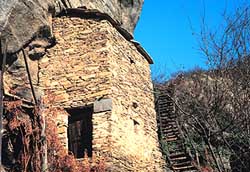|
Le Balme del Monte Bracco - 2

Balma Boves si raggiunge facilmente, con circa
mezz'ora di cammino, partendo dalla frazione Robella, a circa
1 km dopo Sanfront sulla strada per Paesana; si imbocca sulla
destra la via Monbracco di Robella, e superato il ponte sul Po,
ad un bivio si prende la stradina a sinistra, in salita, fino
ad alcune cascine (Case Brondin); da qui inizia il sentiero, in
mezzo a un bosco di castagni.
L'insediamento si trova sulla destra della mulattiera,
vicino ad una cascatella che precipita dalla parete di roccia;
alcune delle case sono ormai pericolanti, e vicino ad esse si
trovano attrezzi agricoli come slitte e gerle; una di esse è
raggiungibile mediante una lunga scala in legno con mancorrente,
ormai non più molto sicura. Assolutamente particolari sono
i tetti, del tutto piatti, essendo le case completamente riparate
dalla roccia, tanto da somigliare ad una specie di "pueblo".
Continuando sulla bella mulattiera sulla sinistra,
in mezzo a un prato con castagni isolati, si raggiungono, dopo
circa dieci minuti di cammino, le Case Forano, abitate tutto l'anno.
Da qui si imbocca il ripido sentiero sulla destra - delimitato
da lastre di pietra (lose) verticali, infisse nel terreno - che
risale il costone, fino a un punto molto panoramico; si prosegue
sul sentiero, a destra di una casa, e in breve si raggiungono
altre "balme", sotto le quali vi sono piccoli edifici
addossati alla parete rocciosa; dopo circa mezz'ora di cammino
(dalle Case Forano) si giunge al dirupato Combal Reinaudo, dove
vi sono molti roccioni; in località Solie, sulla destra
della mulattiera, vi la Roca 'd la Casna, una lastra di pietra
orizzontale e aggettante nel vuoto, con incisioni rupestri. Su
di essa vi sono coppelle, croci e 23 figure antropomorfe, con
le gambe a triangolo e braccia orizzontali; le figure femminili
sono distinguibili da due coppelline incise, rappresentanti i
seni, ali lati del busto.
Vi sono varie ipotesi circa il significato e
la datazione di queste incisioni; le figure sono sicuramente da
attribuire al paziente lavoro dei pastori della zona, mentre le
coppelle fanno pensare all'uso della pietra per riti propiziatori.
Nei pressi vi sono piazzole con muretti a secco, fino agli anni
'20 qui vi era la teleferica per il trasporto a valle della quarzite
estratta dalle cave sovrastanti, raggiungibili ora tramite la
strada dall'altro versante del Monte Bracco.
|
The Mt. Bracco shelters
- 2

It is possible to easily reach Balma Boves by an half an hour
walk, starting from the Robella hamlet, which is situated about
1 km far from the road for Paesana; you need to take right the
Monbracco di Robella road and, once passed the bridge over the
Po river, at a crossroad take the little ascending road on the
left, till the Brondin houses; from here the path starts, going
on in a chestnut wood.
The Balma Boves hamlet is
situated on the right side of the path, near a little waterfall;
some houses are tottering and near them it is possible to find
farming tools like sledges and panniers; the roofs, completely
flat, are quite peculiar: in fact the houses are perfectly sheltered
under the rock, like a kind of pueblo.
Going on along the nice path it is possible to reach after ten
minutes of walk the Forano Houses (Case Forano), inhabited all
year long, surrounded by a meadow and some isolated chestnuts.
From here you can take the steep path on the right, delimited
by vertical rock slabs, which ascends the slope, till a very panoramic
point; going on along the path, at the right side of a house,
you will reach other "balme" (shelters), under which
you can find little buildings; after half an hour of walking (from
Forano houses) you will reach the steep Combal Reinaudo, with
a lot of big rocks; at the site called Solie there is the Casna
rock (Roca la Casna), an horizontal rock slab jutting out hosting
some interesting engravings, like cup-marks, crosses and 23 anthropomorphic
figures, with legs like a triangle and horizontal arms. Female
figures are marked by two little cup-marks, representing the breast,
at each side of the bust.
Many hypothesis were suggested about the meaning and the dating
of such figures; they are surely to be related with the work of
the shepherds of the area; cup-marks could be related with propitiatory
rites. Nearby it is possible to find stone wall terraces: till
the '20s here there was a cableway to transport downside the quartzite
extracted from the quarries of the top of the Mt. Bracco. Now
the quarries are reached by a road passing form the other side
of the mountain.
|